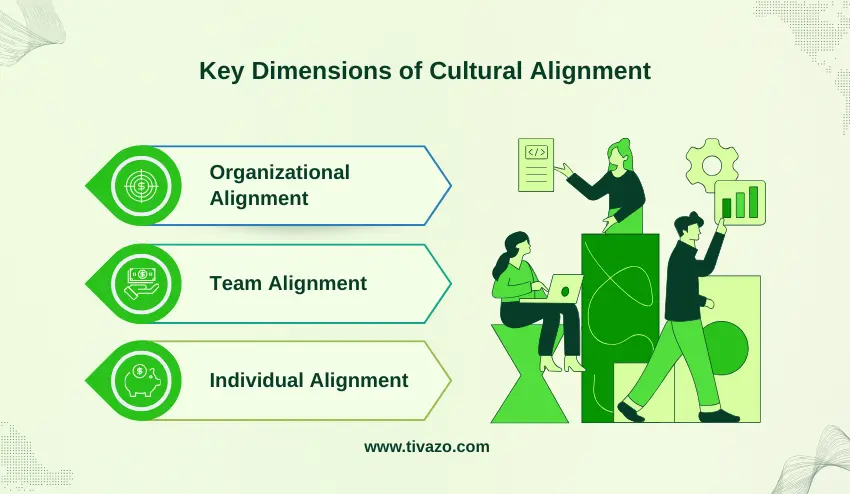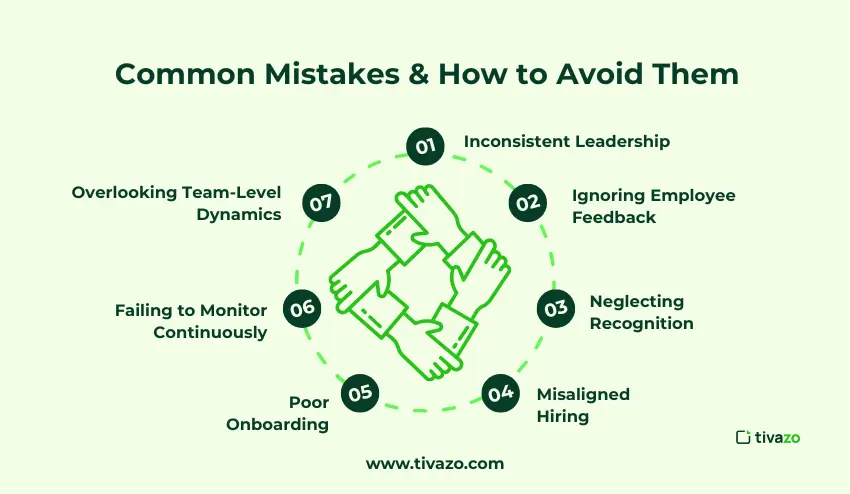In the present-day dynamic work environment, cultural fit can or break an organization. The teams flourish, the engagement is high, and productivity increases when the values, behaviors, and expectations of employees align with the mission and culture of the company. Conversely, misalignment may result in low morale, high turnover and poor collaboration.
This blog will make you realize what cultural alignment is, why it is important to employees and organizations, how to measure it, and what strategies can be applied in practice to promote it. As an HR expert, manager or business leader, you will get practical insights that will enable you to build a workplace where all values, goals, and behaviors are pulling in the same direction.
At the conclusion of this guide, you will have the tools, templates, and real-life examples to reinforce the culture of your business and make sure that all of its members, the leadership to the frontline workers, are on track and motivated.
What is Cultural Alignment?

Cultural alignment is a situation where the values, mission and behaviors of an organization are congruent with that of the employees. In simple terms, it is when the company is what its people believe and do.
Scenario: think of a firm that highly regards innovation and has strict processes. The fact that their behavior and values do not match the organizational culture may make employees feel frustrated, stifled, or disengaged. On the other hand, employees are motivated, collaborative and engaged when values are equal.
Key Dimensions of Cultural Alignment
There are three levels on which cultural alignment functions in an organization. Knowing these assists leaders in detecting loopholes and creating a harmonious working environment.

1. Organizational Alignment
This makes mission, vision, and core values of the company clear, consistent, and well portrayed by the leadership. By modeling organizational values by leaders, employees know what is expected and rewarded.
Example: An organization that embraces innovation promotes experimentation and glorifies innovative problem-solving. The staff members are empowered since the leadership ensures that these values are upheld.
Advice: Disseminate the values in core messages on a regular basis, by holding meetings, newsletters, and performance reviews.
2. Team Alignment
Team alignment is concerned with the norms of collaboration, styles of communication, and common goals in departments or project teams. Despite the high organizational alignment, friction may arise when the members of a team work under different expectations.
Example: Customer support team with a focus on transparency has frequent feedback meetings and openly discusses achievements and challenges, developing trust and responsibility.
Hint: Clearly state the team norms, then check-in regularly to ensure the team knows what’s expected of them.
3. Individual Alignment
This level considers how well individual employee values, motivations, and behaviours align with the organization. Even high-maintaining teams, if a poor fit is the case, would disengage or turnover.
Example: An employee with a high score on work-life balance may not be successful in those organization whether long hours are always valued. The organization increases retention and satisfaction when their policies and recognition programs align with the personal values of employees.
Trick: Hiring should include questions that are based on value, offer flexible policies, and growth opportunities based on the goals of the employees.
Lesson: Cultural alignment involves alignment at an organizational level.
Signs of Cultural Misalignment
The misalignment of cultures might undermine the performance, engagement, and employee satisfaction within the team without a cry. Early identification of the signs assists organizations to act in the right direction before the issues get out of control.
Common Indicators:
- High turnover: Workers often quit due to lack of compatibility of values between the organization and theirs.
- Little involvement: Teams demonstrate the absence of motivation, participation, or enthusiasm.
- War or ineffective teamwork: Incompatible behaviors result in confusion and tension.
- Lack of uniformity in decision-making: The employees have different interpretations of company values, thus causing confusion.
Metrics to Watch:
- Low scores on employee engagement.
- Large levels of absenteeism or burnout.
- Poor attendance to surveys or internal programs.
Tips: Periodic culture surveys and feedback sessions should be held to identify the misalignment at an early stage. Measurement of time to trace the trends and be proactive.
What is a Cultural Alignment Interview?
A cultural alignment interview refers to a kind of interview, which is aimed at evaluating the compatibility of values, behaviors, and work style of an applicant with the culture of an organization. This interview does not emphasize on skills and experience as in the traditional interviews, but it assesses the ability of a candidate to succeed in the environment of the company.
Key Elements:
- Value-Based Questions: Inquire the candidates about the way they managed the situations in their former jobs that demonstrated the core values of the company.
- Behavioral Scenarios: Introduce situations that are likely to arise in your organization and observe the reaction of the candidates to these situations.
- Personality and Motivation: Determine the motivation of the candidate and its alignment with the culture of the company.
Example: In case teamwork is one of the values, a candidate might be questioned: “Can you tell about a situation when you needed to solve a conflict in a team? How did you approach it?” Their reaction indicates that they are in harmony with the norms of collaboration.
Why It Matters:
- Avoids unfit employees within the organization resulting in unwanted turnover and inefficiency.
- Establishes a sense of community and inclusiveness by confirming a match of the organization’s values and behaviors with newly hired employees.
- Encourages long-term inclusion and retention.
Tip: Integrate the cultural alignment interview to the alignment of skills for hiring skilled/culturally aligned candidates.
How to Build & Maintain Cultural Alignment
The establishment of a cultural alignment in an organization must be done purposefully on the leadership, team, and individual levels. The following are some of the strategies that can be used to ensure alignment:
1. Define and Communicate Core Values
Be clear on your mission, vision and values of your organization. Show them onboarding materials, team meetings, and internal communications. These values ought to be modelled by the leadership.
Example : A firm that appreciates innovation can showcase cases of creative problem-solving at all-hands meetings.
2. Hire for Cultural Fit
Incorporate cultural allignment in the hiring process by evaluating values, motivations and behaviors of candidates with skills. Questions in behavioral interviews will help to show how a candidate fits in the company culture.
Example: Inquire the applicants about how they managed collaborative problems in order to determine their values and style of working in a team.
3. Onboard with Culture in Mind
Early induct new workers into the values, expectations and behavioral norms of the company. Add mentorship programs or buddy systems to support cultural understanding.
4. Align Leadership Behavior
Leaders should always be role models in terms of organizational values. Unpredictable actions by the managers can cause confusion and disengagement amongst the employees.
Note: Culture-specific goals should be included in leadership performance appraisals.
5. Foster Open Communication & Feedback
Promote open communication, frequent check-ins and feedback. This assists in identifying the misalignment at an early stage and makes the employees feel listened to.
6. Recognize & Reward Aligned Behavior
Reward employees who portray company values at work. Rewards strengthen the behaviors that one wants and encourage others to do the same.
7. Monitor & Adjust Continuously
Periodically evaluate cultural alignment through surveys, performance indicators, and employee feedback. Implement changes depending on the results to ensure a healthy culture in the long term.
Micro Case Study: A company has been holding quarterly culture surveys, and it has observed that one group has stopped to engage. Leadership put in place specific workshops and mentorship, which was able to score 18 percent higher in six months.
Common Mistakes & How to Avoid Them
Even organizations that are determined to have cultural alignment may be facing difficulties unless pitfalls are avoided. Being aware of these errors and actively working to rectify them will guarantee greater engagement, retention, and productivity.

1. Inconsistent Leadership
Leadership dictates the tone of the organization. In the case of leaders who do not set the example of the values of the company, they send the employees mixed signals of what is really valued. An example is when a manager who promotes teamwork does not engage in group discussions and only takes part in the team discussions occasionally.
To avoid this, the leadership must be held responsible in terms of showing cultural behaviors. Implementing culture-related goals in performance analysis and rewarding leaders who continuously demonstrate the values will strengthen the cultural alignment within the organization.
2. Ignoring Employee Feedback
Feedback should be collected only with the purpose of taking action. Most organizations receive employee feedback but do not act on issues, and this destroys confidence and participation. Indicatively, employees can point out poor communication or failure to recognize them as a major problem.
Regular feedback loops in the form of surveys, focus groups, or one-on-one check-ins should be created by organizations and then insights and additional actions should be shared. Following the employee feedback proves that the company considers their opinion and increases cultural alignment.
3. Neglecting Recognition
Rewards are an important device that can be used to strengthen the desirable behaviors and organizational values. Motivation may be affected when the employees are always exhibiting behaviors that are in conformity with the culture but they are not rewarded. As an example, the mentor employee who initiates the mentoring of new employees or leads on team projects may feel unappreciated when their efforts are not realized.
Organizations must rejoice in congruent conduct by shouting out teams, awarding, or rewarding. This does not only inspire the person but also gives a good example to others to emulate.
4. Misaligned Hiring
Employment without looking at cultural allignment may destroy organizational alignment. Cultural alignment interview, behavioral questions and value based assessment during the recruitment process will help to ensure that the new hires are not only technically qualified but also culturally aligned. As an illustration, inquiring candidates about how they resolve teamwork conflicts or ethical issues will give one a clue about whether they are collaborative or integrity-oriented in their values.
5. Poor Onboarding
Onboarding is not just about clarifying job responsibilities but it also familiarizes the new employees with the values, expectations, and behavioral standards of the company. In cases where culture is not considered in the onboarding process, employees can adopt habits or attitudes that are not in line with the organizational values.
An effective onboarding program also incorporates culture-based sessions, mentorship programs, and check-ins to support the learning. As an example, when a company hires a new employee, it is essential to appoint a mentor, who will demonstrate the company values so that the new employee will be aligned on the first day of employment and will be interested in staying in the company.
6. Failing to Monitor Continuously
Cultural alignment is not a short-term project, it needs to be followed through. Companies that do not keep track of alignment will find themselves disengaging slowly and behaving in a manner that is not aligned. The periodic monitoring of the engagement indicators, survey outcomes, and team dynamics will enable the identification of possible problems in time.
As an example, quarterly culture surveys can show that the engagement in a particular department is decreasing, and specific workshops or coaching sessions can be used to bring the department back on track. Constant watch makes culture healthy and change-based.
7. Overlooking Team-Level Dynamics
Although company-wide values may be evident, teams may come up with their own norms which do not agree with the organizational culture. Such discrepancies may result in friction, confusion or disengagement. Cohesion can be achieved by defining team norms, frequent check-ins, and peer feedback that is based on company values.
As an instance, a distant group may form informal communication patterns which interfere with the organizational norms. Specialized workshop to align the team activities with the company expectations will restore order and enhance performance.
Conclusion
Cultural alignment is an essential component of organizational effectiveness. When employees have values, behaviors, and work styles congruent with the company’s mission and culture, engagement increases, teams work more effectively, and retention is improved. The opposite is also true: misalignment leads to disengagement, conflict, and turnover.
You can create an organization that has all employees pulling in the same direction by understanding the key dimensions of cultural alignment, avoiding the same mistakes, and using some practical approaches that reflect the company’s culture in hiring and onboarding, employee feedback, and employee recognition.




